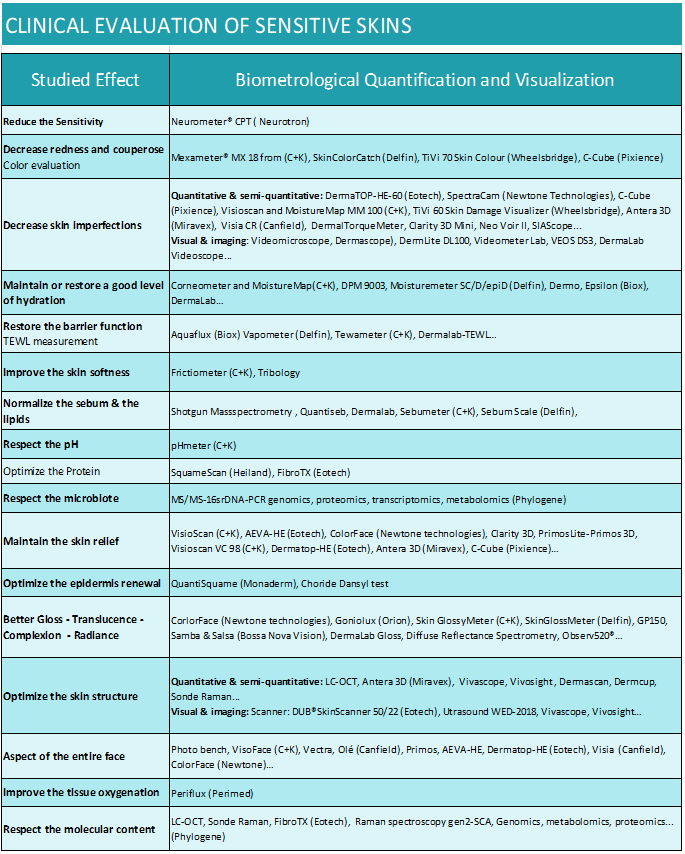How to Evaluate Sensitive Skin by Skinobs via Industries Cosmétiques
18 May 2021
The skin plays multiple roles of protection, perception, immunity, regulation or blood and lymphatic reservoir for the whole body. Thanks to several mechanical, chemical or biological (sebum, biofilm …) reactions, the skin ensures its integrity according to the various endogenous or exogenous environmental variations. Today, the increase in the fragile phenomena of skin is a major issue in the development of the dermocosmetics.
The concept of sensitive skin has been a topic of news for more than 30 years for the formulators of the cosmetic industry. Skin irritation, sometimes confused with allergic skin, results in redness, flaking, vesicles. Sensitive skin is often associated with a consumer’s feelings. Since the years 90 there has been an evolution in the understanding of this skin mechanism in Europe that has led to the development of products specifically oriented towards this type of skin. The contribution of academic research in the fields of cutaneous innervation, intercellular communication, proteomics, or genomics has made it possible to better understand this skin and to develop products that are always more adapted and targeted.
Three mechanisms have been identified as potentially involved in the physiology of sensitive skins. This is:
- the disruption of the barrier function,
- the specific nervous system,
- the involvement of immune cells.
In fact, the loss of the skin barrier function causes a decrease in the protection of the cutaneous nerve fibers and exposes them to the external environment. The density of nerve fibers present in the skin can also play a role. Finally, neuronal hyperactivity is explained by the presence of receptors that no longer protect, but induce sensations of pain, warmth and itching in the skins Sensitive
Thus, sensitive skin can affect all periods of life, ranging from infants to seniors. Babies are particularly prone to redness and irritation due to their still immature skin barrier. They have a lower hydrolipidic film, a thin dermis, a more permeable skin and almost non-existent protection against the sun and the heat. The skin of teenagers may also have a certain sensitivity because of aggressive cleansers uses, leaving the skin hypersensitive. For mature skins, these are particularly vulnerable to external aggression; The activity of the sebaceous glands slows over the years and the skin becomes thinner and more dehydrated.
The constant use of hydroalcoholic gel and soap on hands, becomes a new parameter to be taken into consideration in considering the sensitivity of the skin hand. The resulting change in the skin ecosystem is significant and can be akin to the dryness and the alteration of the skin barrier.
Called “Dermatosis Invisible”, “atopy”, or “reactive skin”, sensitive skin is a recent phenomenon as it would have been described for the first time in the second half of the XX century. This is a common disorder that now affects more than one French in two and is widespread throughout the world. Today we know that 1 French in 2 is affected, whereas in China and South Korea it is 62% of women who have sensitive skin. The causes of the higher prevalence in Asia compared to European countries would be due to overwork and stress, as well as to being exposed to pollution in large cities.
Clinical studies associated to biometrological assessments in vivo on Human enables the observation of functional cutaneous signs will allow to describe the healthy skin and the different signs of sensitive manifestations. The soothing effects are associated to respond to environment (water, wind, sun, pollution, cold) specific skin physiological conditions, internal factors or lifestyle.
Formulations for sensitive skins generally contain few ingredients, (only the necessary, no superfluous ingredients), limited preservatives, adapted filters, and little or no fragrance. From these advances, some brands formulate skincare to avoid irritation or aggression from ingredients characterized by their low potential irritant or allergenic, coupled with moisturizing principles or constituents of the skin barrier. Others will provide a more symptomatology response with specialties designed to correct unrest and disorders found such as inflammation, discrete vasodilation and where the sensations of tingling and warming. After the Dewy wave, a new emerging trend coming from South Korea, the Skip Care, focusing on quality rather than the number of cosmetic products used routinely. The goal is to return to a simpler beauty routine, identifying the essential ingredients in order to avoid any use of unnecessary products. To do this, we find multifunction products with for adage: less products for the same profits. The idea is to focus on 2 steps: cleaning and hydration. However, this is linked to the problematic of sensitive skins which only seek the strict necessary in formulas.
Thus, cosmetic products, first protect, then restore the barrier function, strengthen the extracellular matrix, repair, soothe pruritus and itch, regenerate or calm irritations and redness. They can also reduce the inflammation and help to treat both allergic contact and atopic dermatitis, even if it is not cosmetically correct to say it under some regulation latitudes.
Skinobs Clinical testing Platform lists more than 30 methods that meet this claim, in addition to other methods such as consumers testing, clinical scorages, sensory analysis and well-being studies.
Test under dermatological control
- Consumer testing including large sensitive skin panel answering questionnaire.
- Stinging testing: testing the sensory answer in the nose wings lactic acid, capsaicin or dimethylsulfoxyde.
- BoSS : Burden of Sensitive Skin questionnaire including 23 questions (L. Misery June 2017 JAAD)
Major innovations in the perception objectivation remain to come if it considers the latest research on sounds, taste, smell or vision receptors present in the keratinocytes as specified by Mr Briand (INRA), and Mrs Broussard (Shiseido), during the recent JP Marty days on the barrier function topic.
In complementary ways, the testing innovations will be initiated with new active developments, without talking about the most promising role of cannabinoids in the treatment of itch. The more the mechanisms behind the sensitive skin phenomenon will be understood, the more cosmetic industries will be able to offer effective and durable solutions to treat sensitive skins, through the elaboration of formulations targeted specifically these mechanisms.
Anne Charpentier, Skinobs founder
Published by Industries Cosmétiques
Download the entire publication…
CONTACT









 Follow us on Linkedin!
Follow us on Linkedin!
You must be logged in to post a comment.